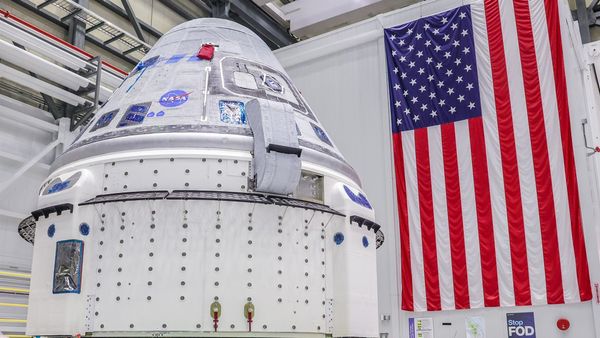
Saturn has quite the collection of moons, more than any other planet in the solar system. There’s Enceladus, blanketed in ice, with a briny ocean beneath its surface. There’s Iapetus, half of which is dusty and dark, and the other shiny and bright. There are Hyperion, a rocky oval that bears a striking resemblance to a sea sponge, and Pan, tiny and shaped just like a cheese ravioli.
But one moon might be missing.
According to a new study, Saturn once had yet another moon, about the same size as Iapetus, which is the third-largest satellite in Saturn’s collection. The moon orbited the ringed planet for several billion years, minding its own business, doing moon things, until about 100 million to 200 million years ago, when other Saturnian moons started messing with it. The interactions between them pushed the unlucky moon closer to Saturn—too close to remain intact. Gravity shredded it to bits.
Something remarkable might have come out of all this. While most of the moon debris fell into Saturn’s atmosphere, some of the pieces hung back, whirling around the planet until they splintered further and flattened into a thin, delicate disk. This lost moon, the authors of the study say, is responsible for Saturn’s trademark feature: the rings.
These astronomers didn’t set out to find a missing moon. They were trying to better understand why Saturn is the way it is now—specifically, why the planet is tilted just so. “Planetary tilts are an interesting indicator of a planet’s history,” Zeeve Rogoszinski, an astronomer at the University of Maryland who was not involved in this recent work but who studies orbital dynamics, told me. Most of the planets in our solar system spin at an angle relative to the plane in which they orbit the sun. Earth’s tilt, for example, is a result of the collision that scientists believe might have created our moon. Mars’s tilt is chaotic, thanks to the influence of next-door neighbor Jupiter. Uranus likely got its dramatic lean after the planet was whacked with a massive rocky object a few billion years ago.
[Read: The long goodbye to Saturn’s rings]
Astronomers have known for years that Saturn owes its particular tilt to gravitational interactions with Neptune. “Saturn is a spinning top, and how quickly that spinning top is rotating is in sync with how quickly Neptune’s orbit is spinning around,” Brynna Downey, a planetary scientist at UC Santa Cruz and one of the study’s authors, told me. “It’s not obvious why they should affect each other—but they do.” Researchers refined that picture recently; using data from NASA’s Cassini mission, they showed that Titan, Saturn’s largest moon, plays a role in all of this too. Titan is drifting away from Saturn quite rapidly, and the withdrawal is significant enough to sway the planet and cause that connection with Neptune.
Downey and her colleagues sought to investigate these phenomena more deeply, using more measurements of Saturn’s interior taken by the Cassini mission, which ended five years ago when NASA deliberately sent the probe careening into the ringed planet’s atmosphere. (That’s the way space exploration goes sometimes.) Their work showed that Saturn appears to be slightly out of sync—or resonance, in astronomy terms—with Neptune. And they wondered, how on Earth—er, Saturn—did that happen?
So the researchers ran computer simulations, rewinding the tape on the Saturnian system and tinkering with orbital dynamics to reproduce the configuration they had discovered. After trying out all manner of what-ifs, the team could only explain it this way: A long-lost moon once tugged at Saturn, helping it maintain its cosmic vibe with Neptune, until the moon was kicked out of its orbit. “It was a huge surprise,” Downey said. “It’s much more common to say, ‘Here’s this really niche, very particular resonance of some kind that very few people have heard of.’” But “none of that worked,” she said.
[Read: This picture has major moon potential]
The researchers say the moon’s demise was mostly Titan’s fault. The big moon jostled the smaller one, putting the object on a very elongated track around Saturn. The new orbit was “so elliptical that the moon has a close encounter with Saturn, and Saturn then rips it apart,” Jack Wisdom, a planetary scientist at MIT who led the latest study, told me. The team has named the lost moon Chrysalis because, according to a press release, “it blossomed into the rings much as a chrysalis transforms into a butterfly” (a nice framing that skips over the whole Titan-being-a-jerk bit).
This claim fits somewhat neatly into one side of a major controversy over the rings’ origins. Some scientists think the bands arose billions of years ago from the raw materials of the early solar system that created Saturn itself. Others say the rings appeared much later, when some celestial object got too close to the planet, as recently as 100 million years ago. (This is considered “recent” for astronomers.) Cassini data support the latter theory, and astronomers seem to be coming around to it, including those who worked on the new findings. For them, Saturn’s behavior, the missing moon, the gleaming disk of icy chips and chunks we see today—“everything lines up,” Wisdom said.
But Saturn’s missing moon is hypothetical, and the effect of its loss on Saturn is only a theory, one that must stand up to scrutiny from other teams. Last year, a group of scientists published research on Saturn’s tilt, but their work was premised on the idea that the planet remains in resonance with Neptune. In that case, there was no need to invent a mechanism that would have knocked it out of sync. Wisdom and his team’s findings present an appealing scenario, but “this story needs a fine-tuning of all the elements at play,” Giacomo Lari, a research fellow at the University of Pisa and one of authors of the study from last year, told me. Where Wisdom sees a well-reasoned narrative, Lari and his colleagues see “a succession of unlikely events.”
[Read: The moon is leaving us]
The tricky part about understanding Saturn—or any planet—is that change happens on far greater timescales than we human beings are capable of comprehending. We can see the solar system only as it is now, and now is an infinitesimal moment in cosmic history. So we rely on the measurements we have and imagine pasts that might have been, weighing potential theories that could explain what’s out there today. “Unless you travel back in time 4 billion years and observe the evolution of the solar system, you’ll never really know,” Rogoszinski said. “That’s all we can really say, is you have two models; one works so much better than the other.”
A couple of weeks ago, I did my own, very unscientific check-in with Saturn using a telescope that my neighbor had set up on the roof of our apartment building. It looked the same as it always does, like a little bumblebee in the darkness, its bright rings jutting out like wings on either side. Tell us your secrets, Saturn! I thought. And those of your moons too—the dozens we’ve discovered, the ones we haven’t yet detected, and those that may be long gone, lost before anyone was around to wonder.







